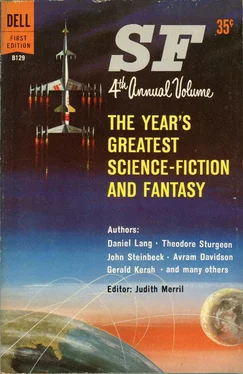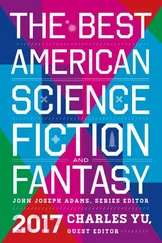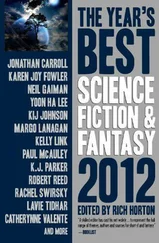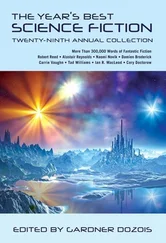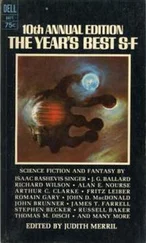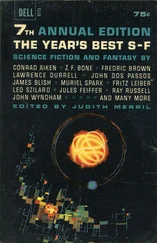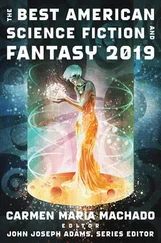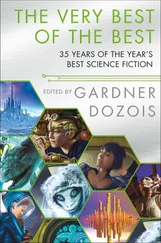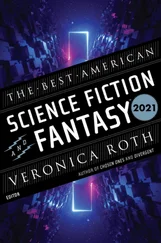Judith Merril - The Year's Greatest Science Fiction & Fantasy 4
Здесь есть возможность читать онлайн «Judith Merril - The Year's Greatest Science Fiction & Fantasy 4» весь текст электронной книги совершенно бесплатно (целиком полную версию без сокращений). В некоторых случаях можно слушать аудио, скачать через торрент в формате fb2 и присутствует краткое содержание. Год выпуска: 1959, Издательство: Dell, Жанр: Фантастика и фэнтези, на английском языке. Описание произведения, (предисловие) а так же отзывы посетителей доступны на портале библиотеки ЛибКат.
- Название:The Year's Greatest Science Fiction & Fantasy 4
- Автор:
- Издательство:Dell
- Жанр:
- Год:1959
- ISBN:нет данных
- Рейтинг книги:5 / 5. Голосов: 1
-
Избранное:Добавить в избранное
- Отзывы:
-
Ваша оценка:
- 100
- 1
- 2
- 3
- 4
- 5
The Year's Greatest Science Fiction & Fantasy 4: краткое содержание, описание и аннотация
Предлагаем к чтению аннотацию, описание, краткое содержание или предисловие (зависит от того, что написал сам автор книги «The Year's Greatest Science Fiction & Fantasy 4»). Если вы не нашли необходимую информацию о книге — напишите в комментариях, мы постараемся отыскать её.
The Year's Greatest Science Fiction & Fantasy 4 — читать онлайн бесплатно полную книгу (весь текст) целиком
Ниже представлен текст книги, разбитый по страницам. Система сохранения места последней прочитанной страницы, позволяет с удобством читать онлайн бесплатно книгу «The Year's Greatest Science Fiction & Fantasy 4», без необходимости каждый раз заново искать на чём Вы остановились. Поставьте закладку, и сможете в любой момент перейти на страницу, на которой закончили чтение.
Интервал:
Закладка:
But now the anti-proton has been artificially formed and anti-matter is no longer to be found only in the speculations of science fiction.
True, no one has actually been able to create anti-matter itself out of individual anti-particles, since any given anti-particle only exists for a millionth of a second or less before combining with an ordinary particle and vanishing in a blaze of energy. However, astronomers such as Fred Hoyle (who has also taken to writing science fiction) are speculating on the possible existence of chunks of antimatter elsewhere in the universe.
For instance, there are two galaxies in the constellation of Cygnus that are colliding and releasing incredible floods of radio waves. Is this just due to the turbulence of colliding dust clouds? Probably. On the other hand, what if one galaxy is matter and one anti-matter? Hoyle’s calculations lead him to think the amount of energy being released as radio waves is just the amount a gradual matter/anti-matter collision would release.
There is also Messier 87, an unusually bright galaxy which emits copious radio waves although it is not colliding with another galaxy. Has it picked up a sizable gob of anti-matter somewhere that is not yet completely digested?
A physicist named Goldhaber, at Brookhaven, speculates that two universes were formed at the beginning, a universe of matter and an anti-universe of anti-matter, the two flying apart because of gravitational repulsion (anti-gravity).
But is such a thing as anti-gravity conceivable? There are electrostatic forces that attract (between unlike charges) and repel (between like charges). There are magnetic forces that attract (between unlike poles) and repel (between like poles). Gravitational forces, however, are only attractive and Einstein’s theories make no provisions for anything like gravitational repulsion.
And yet, in the last month, I have read a report to the effect that, under special circumstances, subatomic particles acting as though they were made up of “negative mass” could be detected. “Negative mass” would be mass which, under the influence of a gravitational field would show an acceleration opposite in direction to that of “positive mass.” In other words, something of negative mass would fall upward. In still other words, you have anti-gravity.
The implications of all this serious scientific work and thought is colossal. If you can find bodies of anti-matter anywhere, you have a source of energy far greater per unit mass than even hydrogen-fusion. Anti-matter is a fuel that could convert all its own mass and an equivalent mass of ordinary matter into energy. Hydrogen-fusion converts less than one per cent of the mass of hydrogen into energy.
On the other hand, any sizable chunk of anti-matter would be the most dangerous explosive conceivable, and the most un-handleable. How, then, would it be handled?
Jack Williams, among others, dealt with this problem in his book, See-Tee Shock. (In those days, a long decade ago, anti-matter was called “contra-terrene matter” and “see-tee” is the phonetic equivalent of the abbreviation c. t.) But now the purely science-fictional quality of the notion is weakened.
Or suppose we can make (or find) negative mass in quantity and add it to the ordinary positive mass of a spaceship? Would we not have, possibly, a spaceship with a total of zero mass and hence zero inertia? Is not this the inertialess drive featured in E. E. Smith’s famous “Lensman” stories?
Or if we had ways of varying the balance of positive and negative mass in the ship, we might maneuver in space by appropriately repelling or attracting cosmic bodies at any acceleration and do without power altogether—Oh, dreams, dreams!
Or are they dreams? How far can we expect the Thunder-Thieves to go?
If space is slipping out of the realm of s-f, what about time?
Einstein first suggested that time was not absolute; that to a person in motion, time passed more slowly than for a person at rest; and that with rapid motion, the difference in experienced time became sizable. With motion rapid enough, a speeding man could live one year while people on Earth were living through a million.
Various s-f writers have made use of this notion to allow their heroes to reach the stars. L. Sprague de Camp uses it routinely in his Viagens lnterplanetarias stories and L. Ron Hubbard centered his story “To the Stars” about it.
Recently, physicists have argued violently as to whether this “time dilatation” effect is a true one, or only an appearance depending on an observer’s frame of reference. As an amazing sign of the times, this rarefied argument has reached the public press.
What is still more exciting is that a definite experiment is being planned to take the question out of the realm of argument and into that of observation. New “clocks” have been invented which measure time by counting the vibrations within molecules. These vibrations are so unvaryingly constant that the new clocks, called masers will keep time within one part in ten billion (that is, with an error of not more than a third of a second per century).
Now suppose you synchronize two masers, so they are vibrating exactly in time. Keep one maser on Earth and send one up in a satellite which will circle Earth at the usual speed of twenty thousand miles an hour, or thereabouts. At that rate of motion, time within the satellite, if slowed according to theory, will cause the maser to lag 1/20,000 of a second each day. The satellite maser, sending back its radioed signals, will move out of phase with the Earth maser.
Perhaps by the time this sees print, the experiment will be performed. If it proves the existence of time dilatation (as I rather think it will) it means distant galaxies can, theoretically, be reached in one man’s lifetime. This will render old-fashioned such great stories as Heinlein’s “Universe” in which generations of men were required for the voyage to other stars.
Of course, while one man is making an inter-galactic trip and back, uncounted generations are living and dying on Earth, so this also makes one type of time-travel—into the future—a conceivable possibility, and weakens the purity of still another science-fictional plot variety.
Nor is our own Earth safe! Do we write about robots? (I do.) Well, World War II saw the development of the computer to the kind of perfection that points (as yet but distantly) toward A. E. van Vogt’s Games Machine in the “Null-A” stories. We now have computers which can be programed in such a way that they will play a fair game of chess or translate from Russian to English.
Of course, these are tremendous machines. To get a true science-fictional robot, we need a man-shaped, man-sized computer. That means miniaturization.
The real space-consumers in computers are the radio-tubes, or analogous devices which act as stop-and-go devices that determine the exact routes followed by electric currents. Transistors, composed of tiny germanium crystals, do the work of radio-tubes in much smaller space. And now “cryotrons” are being developed. These are merely two wires at liquid helium temperatures. By making use of superconductivity (the tendency of certain metals to have zero resistance to an electric current at temperatures near absolute zero) these wires can be made to stop-and-go electric currents in even less space than do transistors.
Miniaturization is proceeding apace. Robots, tremble!
Or perhaps it is a matter of androids, rather than of robots. Perhaps you’re thinking of mechanical men built out of artificial flesh and blood. Artificial life, to put it most bluntly.
Why not? Biochemists are isolating nucleoproteins from cells and are using them to synthesize proteins in the test-tube. (Nucleoproteins are the substances within cells that act as “blueprints” in protein formation.) Hemoglobin has thus been formed without the intervention of living, intact cells. Man is using the “blueprints” directly.
Читать дальшеИнтервал:
Закладка:
Похожие книги на «The Year's Greatest Science Fiction & Fantasy 4»
Представляем Вашему вниманию похожие книги на «The Year's Greatest Science Fiction & Fantasy 4» списком для выбора. Мы отобрали схожую по названию и смыслу литературу в надежде предоставить читателям больше вариантов отыскать новые, интересные, ещё непрочитанные произведения.
Обсуждение, отзывы о книге «The Year's Greatest Science Fiction & Fantasy 4» и просто собственные мнения читателей. Оставьте ваши комментарии, напишите, что Вы думаете о произведении, его смысле или главных героях. Укажите что конкретно понравилось, а что нет, и почему Вы так считаете.
